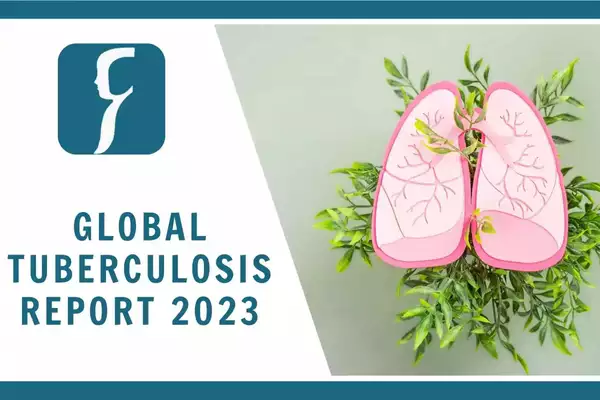The World Health Organization’s (WHO) had released earlier the ‘Global TB Report 2023’, reporting the status of Tuberculosis around the world, including India.

Highlights of the report:
World:
- There was a major global recovery in the number of people diagnosed with TB and treated in 2022.
- However, TB remained the world’s second leading cause of death from a single infectious agent in 2022, after COVID-19.
- The WHO’s target was to reduce TB-related deaths from 2015 to 2025 by 75%, which may be missed.
- India, Indonesia and the Philippines, collectively accounted for a large share (≥60%) of the global reductions in the number of people newly diagnosed with TB in 2020 and 2021, all recovered to some levels in 2022.
- In 2022, 55% of people who developed TB were men, 33% were women and 12% were children (aged 0–14 years).

[ref-who]
India:
- India accounts for the highest TB burden across the world contributing 27% of all the TB cases followed by Indonesia (10%) and China (7.1%)
- The TB treatment coverage has improved to 80% of the estimated TB cases, an increase of 19% over the previous year.
- There was reduction of TB incidence by 16% from 2015 to 2022, at the double pace at which global TB incidence is declining (which is 8.7%).
- TB mortality has reduced by 18% during the same period in India, and globally.
- Key initiatives of the government include active case finding drives, scaling up molecular diagnostics at the block level, decentralisation of screening services via the Ayushman Bharat Health and Wellness Centres, and private sector engagement.

[ref-WHO]
About the Tuberculosis (TB):
- The TB is a contagious infection caused by the bacterium Mycobacterium tuberculosis.
- It primarily affects the lungs, however it can also target other organs.
- It is transmitted through airborne particles from infected individuals, especially in crowded spaces with poor ventilation.
- Its common symptoms include persistent cough with sputum or blood, chest pains, weakness, weight loss, fever, and night sweats.
- TB is treatable and curable with a regimen of anti-TB medicines.

[ref- MDPI]
Types of TB:
- Active TB Disease: It is symptomatic and contagious illness in which the bacteria rapidly multiply and invades different organs of the body.
- Miliary TB: A rare form of active disease that occurs when TB bacteria enters the bloodstream.
- Latent TB Infection: The bacteria in the body are inactive, asymptomatic and contagious but can turn into active TB, in absence of treatment.
Multi-drug-resistant tuberculosis (MDR-TB)/RR-TB:
- It is caused by bacterias that are resistant to treatment with at least two of the first-line anti-TB medications (drugs), isoniazid and rifampin.
- People with RR TB are resistant to rifampicin.
XDR (Extensively drug-resistant) TB:
- XDR-TB is resistant to at least four of the core anti-TB drugs.
- People who are resistant to isoniazid and rifampin, in addition with any fluoroquinolone and at least one of the three injectable second-line drugs (amikacin, kanamycin, or capreomycin) are said to have XDR-TB.
Treatment:
- It is treatable disease and curable with antimicrobial drugs.
- Vaccination: Bacille Calmette-Guérin (BCG).
- First-line anti-TB drugs: Isoniazid and rifampicin.
- Drug-resistant tuberculosis bacteria that do not respond to first-line treatment anti-TB drugs.
Government initiatives to curb Tuberculosis:
- National Tuberculosis Elimination Program (NTEP): A flagshipprogram aims to provide free and quality diagnosis and treatment for all TB patients in the country.
- It was launched in 1997 as Revised National Tuberculosis Control Programme.
- National Strategic Plan for Tuberculosis Elimination (NSP 2017-2025): It aims to eliminate TB by 2025, by outlining the strategic approach and activities required to achieve this goal.
- Nikshay Poshan Yojana: It provides financial support to TB patients to ensure that they receive proper nutrition during their treatment and hence aims to improve the nutritional status of TB patients, which in turn helps in better recovery.
- Universal Drug Sensitivity Testing (UDST): It aims to provide drug sensitivitytesting to all diagnosed TB patients, including those with drug-resistant TB.
- It helps in identifying the most effective drugs for treatment.
- Bedaquiline Roll-out Program: Bedaquiline is a new drug used in the treatment of drug-resistant TB that aims to make Bedaquiline available to eligible patients in India.
Ref: Source
| UPSC IAS Preparation Resources | |
| Current Affairs Analysis | Topperspedia |
| GS Shots | Simply Explained |
| Daily Flash Cards | Daily Quiz |


